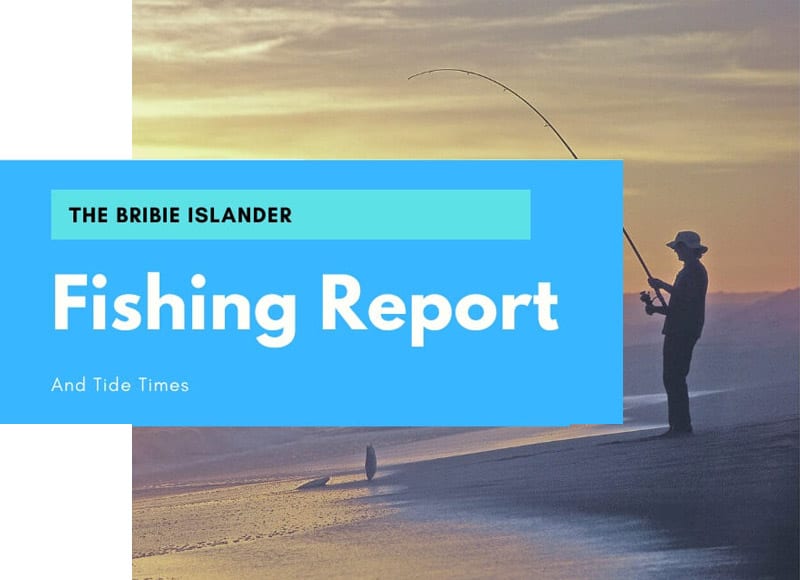FISHING REPORT
We’ve had classic winter fishing conditions lately, with very little interruption to weeks of pleasant, sunny days, with just light afternoon breezes. Whiting has been caught all over the Passage in this weather, but the largest hauls have come anywhere south of Toorbul. Turner’s Camp sandbank is a good place to target both sand and winter whiting. It’s a good idea to know the difference, so I’ll include a couple of pictures. I tell our customers that if the whiting has blotchy marks across its back, they’re winter whiting and don’t need to be measured. They have a bag limit of 50, but summer whiting has a bag limit of 30 and a size limit of 23cm.
Bloodworms are always favoured baits for whiting, but prawns and squid have been working just as well. Kai and Tian brought in ten big whiting from The Ningi Creek yellow marker, caught on prawns and squid, although Kai said prawns were the way to go.
Jacky’s little bag of winter whiting was all caught on squid, up at White Patch. Rob and Jo had about 40 winter whiting between them after a trip to the Beachmere cockle banks. Worms were the bait, some fresh, some frozen, “it didn’t matter”, Rob said, “they were hitting the lines at the front of the boat, at the back and on both sides – all over” It was one of those glassy afternoons, on the last of the falling tide, when it wouldn’t matter if you caught nothing – just happy to be out there.
Riley, Levi and Tyler had one of those days, too. They went out with their mum and dad, sat just north of the bridge close to the mainland for about 3 hours and caught 71 fish between them! Dad said he didn’t wet a line – too busy sorting out the kids. There were a few legal bream and whiting, grunters and a pike, but they all went back into the water anyway. Great fun fishing and seeing dolphins, too – how good does it get?!
There have been a few reasonable flathead catches around the Passage – Cindy got a 60cm one at the Avon wreck, Dennis had a 45cm dusky at Banksia Beach, but the big ones are yet to come. Late winter is a good time for the larger flathead; when the cooler weather brings the breeders into the creeks around the Passage, usually shadowed by a few smaller males. Any of the creeks up the Passage will be holding nice flathead as winter progresses – we just need more of the REALLY cold mornings and maybe a bit more wind to stir things up. All this clear water makes it too easy for the flathead to see what’s going on at the other end of the line. July is often the month that the big flathead fishing takes off.
Flatheads are aggressive and usually attempt to eat anything that passes by. Casting and retrieving soft plastics and hard-bodied lures will all be successful in catching them. Dennis used a Zman Streakz soft plastic in bubblegum pink. Make sure you use the tidal flow if you’re using bait – allow the boat to drift along the sandbanks.
If you’re fishing from the shore, cast out lures over the shallow flats, where the incoming tidal flow washes in bits of food to the fish. Look for signs of a weed bed. Adding some strong leader to your line is always a good idea – they’re pretty good at biting through a regular line.
There’s plenty of tailor about, especially south of the bridge and along Red Beach. The second green beacon on the way and going around towards Sandstone Point is one good spot to fish for them. The week before last, one bubbling, broiling school would have been at least 30 metres across! Lures and bait have both been working on them but with tailor, it’s all about technique. Out on a boat, look for the birds, find the dark patch of tailor and motor slightly upwind and within range of a good cast.
If you’re thinking tailor-fishing from the beach, pilchards are usually favoured, on ganghooks, and with a good strong leader! In the last week of the month, there will be some nice late afternoon high tides, which should be good for tailor from Red Beach and round to the surf-side.
It’s been great camping weather over the last school holidays, so a mate and his boy popped up to Mission Point for 4 nights. Every day, they kept two mud crabs from their pots, to cook for dinner, letting the rest go. All of the muddies were “very full – two were at least 22cm across, the biggest and heaviest I’ve ever seen, both bucks but we let them go, too”.
Sand crabs are less likely to be found in pots and more often swimming past your boat, at this time of year. I was interested to watch some people visiting from the UK, who used a pilchard in a little bag, attached to a handline, to catch their sand crabs. The little bags are, apparently, commonly saved from boxes of dishwasher tablets. My old Grant’s Guide to Fishes mentions this method – but we all go and spend our money on messy, bulky crab-pots…
